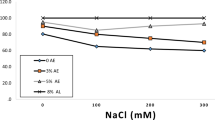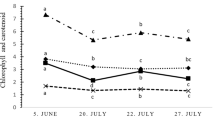Abstract
Frankland and Wareing1 reported that chilling treatments which break the dormancy of hazel (Corylus avellana L.) seeds were also accompanied by an increase in the gibberellin content of the seeds, but that the resultant concentrations of gibberellin appeared to be much too low to account for the subsequent germination of the chilled seeds. On the basis of germination experiments in which hazel seeds were treated with chlorocholine chloride, either during or after a chilling treatment, one of us concluded that gibberellin synthesis in hazel seeds may be an essential part of dormancy-breaking, but that it occurs chiefly after the end of the chilling process2. We have therefore re-investigated the gibberellin content of hazel seeds after subjecting them to 28 days' chilling at 5° C in moist sand, and we have made determinations on similarly chilled seeds after further treatment for 2 or 7 days at 20° C. Before extraction, the testa and pericarp of the seeds were discarded and the embryonic axes were removed from the cotyledons for separate extraction. Treatment of the seeds, extraction with 80 per cent methanol and the preparation of the acidic diethyl ether extracts were carried out as described previously2. The acidic diethyl ether extracts were fractionated by thin-layer chromatography on ‘Kieselgel G’ using a solvent consisting of ethyl acetate, chloroform and acetic acid (15: 5: 1)3. Strips of material from the thin-layer plates were scraped into tubes, to each of which were added 4 ml. of water, 0.1 ml. of streptomycin (250 U) and ten excised etiolated 5 day old pea epicotyls. Gibberellin was bioassayed by the growth of the pea epicotyl above the first node during 3 days at 22.5° C under continuous illumination of 2,500 lux4. A blank thin-layer plate was chromatographed and assayed with each set of bioassays so that an accurate blank value and the least significant differences (P = 0.05) could be calculated5. Responses of the bioassay to a British Drug Houses gibberellin preparation (largely gibberellin A3) which was chromatographed on thin-layer plates indicated that only 10 per cent of the gibberellin was re-extracted from the ‘Kieselgel’ so as to influence the bioassay. Standards of 0.01 and 0.1 nmoles of gibberellin were used, which, after chromatography, gave typical mean stimulations of the upper internodes of the pea epicotyls of 3.9 and 6.9 mm respectively.
This is a preview of subscription content, access via your institution
Access options
Subscribe to this journal
Receive 51 print issues and online access
$199.00 per year
only $3.90 per issue
Buy this article
- Purchase on Springer Link
- Instant access to full article PDF
Prices may be subject to local taxes which are calculated during checkout
Similar content being viewed by others
References
Frankland, B., and Wareing, P. F., J. Exp. Bot., 17, 596 (1966).
Bradbeer, J. W., Planta, 78, 266 (1968).
Cavell, B. D., MacMillan, J., Pryce, R. J., and Sheppard, A. C., Phytochemistry, 6, 867 (1967).
Phillips, I. D. J., and Jones, R. L., Planta, 63, 269 (1964).
Coombe, B. G., Cohen, D., and Paleg, L. G., Plant Physiol., 42, 113 (1967).
Bradbeer, J. W., and Pinfield, N. J., New Phytol., 66, 515 (1967).
Köhler, D., Planta, 70, 42 (1966).
Author information
Authors and Affiliations
Rights and permissions
About this article
Cite this article
ROSS, J., BRADBEER, J. Concentrations of Gibberellin in Chilled Hazel Seeds. Nature 220, 85–86 (1968). https://doi.org/10.1038/220085a0
Received:
Revised:
Issue Date:
DOI: https://doi.org/10.1038/220085a0
This article is cited by
-
The evolutionary ecology of nut dispersal
The Botanical Review (2001)
-
Pentose phosphate metabolism during dormancy breakage in Corylus avellana L.
Planta (1980)
-
The effect of stratification on endogenous cytokinin levels in seeds of Acer saccharum
Planta (1972)
-
Aspects of the cold-hardiness mechanism in plants
The Botanical Review (1971)
-
Studies in seed dormancy
Planta (1971)
Comments
By submitting a comment you agree to abide by our Terms and Community Guidelines. If you find something abusive or that does not comply with our terms or guidelines please flag it as inappropriate.



